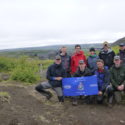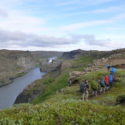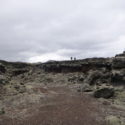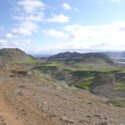This summer, ten officer cadets from Oxford University Officer Training Corps set off to attempt to trek 500 kilometres, unsupported, from the north to the south of Iceland over the course of three weeks. Our leader, Junior Under Officer Graves, had selected a team of nine Officer Cadets from the universities of Oxford, Oxford Brookes, Reading, and Gloucester, ably supported by Lieutenant Chris Woods of the Royal Logistics Corps.
We returned from our annual summer camp in Germany with only a few hours to prepare to depart for Iceland, spending a frantic evening packing and familiarising ourselves with the equipment that would sustain us for the next three weeks. As each team member received 15 kilograms of food, the weight we would be carrying for the next three weeks became painfully real. That evening, we went to bed filled with excitement and anticipation.
As we drove out of Reykjavik, the whole team was in awe at the incredible scenery for which Iceland is famous. A strange mix of flat lunar desert and mountainous Scottish heathland, Iceland’s diversity is unique. After more than a day of travelling, we arrived in the far north of this windswept Atlantic island and waved goodbye to our driver. Suddenly very aware of our isolation but in high spirits, we headed south in the horizontal rain that we would become well accustomed to over the next two weeks.
Our first 175 kilometres were our most difficult. Carrying approximately half of our bodyweight, we walked for eight hours per day along dirt tracks and roads. On account of our isolation, we had no choice but to filter all of our water, drawing it from lakes and rivers that we passed. Almost immediately, this became problematic. Iceland had an unusual Easter this year, experiencing significantly less snowfall than is normal. As a result, the water features that appeared on our maps were, more often than not, dry mud pools. Almost from day one, we were forced to adapt our plan to the unpredictable water sources, thankful for the flexibility that was built into our plan. Sadly, one of our team members was forced to abandon the expedition after developing irreparable blisters on both feet. Diverting to a nearby town, we dropped him off having agreed to meet in the town of Myvátn, which we planned to reach on our eighth day.
Despite constant rain and temperatures that never rose above six degrees Celsius, we walked well ahead of time for the first section of our trip, making extensive use of tracks and roads in order to speed our journey south, conscious of the difficult terrain that we would have to negotiate in the central highlands later on. As we did so, however, it became clear that the weather conditions were not at all what we had expected. Rather than summer conditions, we were experiencing winter ones: a low snowline, cold temperatures, persistent rain, and even snow. At the end of our eighth day, as we arrived in Myvátn, saturated by the constant rain, we abandoned the expedition on the advice of local rangers, who informed us that this was Iceland’s worst summer in over 30 years and that it would be dangerous to continue.
We spent that evening planning how best to make use of our remaining two weeks in Iceland, determined to make them a valuable experience even though we had failed to achieve our initial objective. We decided to head for Akureyri, a northern town that we had passed through on our journey north, and where we knew that there were accessible mountainous day walks. We spent a week exploring the mountains around Akureyri and learning the skills required for our Summer Mountain Foundation qualification whilst we planned our next move.
Determined to explore as much of Iceland as possible, we travelled south to the Reykjanes Peninsula, near Reykjavik, where we joined the famous 130 kilometre-long Reykjavegur trail. Here, we enjoyed the postcard Icelandic experience, swimming in hot springs, crossing lava fields, seeing ancient volcanoes, and eventually reaching the coast. In contrast with the terrible weather that had blighted the first part of the expedition, we enjoyed beautiful conditions and warm temperatures as we walked the trail. We felt as though we had finally been rewarded for our efforts over the previous two weeks.
Exercise Blue Fara would not have been possible were it not for the generosity of the Ulysses Trust, for which all of the team are enormously grateful, and from which we benefitted both individually and as a unit.




